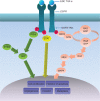EGFR mutations as a prognostic and predictive marker in non-small-cell lung cancer
- PMID: 25302015
- PMCID: PMC4189714
- DOI: 10.2147/DDDT.S69690
EGFR mutations as a prognostic and predictive marker in non-small-cell lung cancer
Abstract
Non-small-cell lung cancer (NSCLC) has entered the age of individual treatment, and increasing point mutations of specific oncogenes and rearrangement of some chromosomes are biomarkers used to predict the therapeutic effect of targeted therapy. At present, there is a consensus among clinicians that epidermal growth factor receptor (EGFR) tyrosine kinase inhibitors (TKIs) have shown favorable efficacy in NSCLC patients with EGFR mutation, and some relevant research has suggested that the presence of EGFR mutations is a favorable prognostic marker. However, the association of EGFR mutation status with the responsiveness to conventional chemotherapy agents and survival in NSCLC patients is still unclear. This review provides an overview of and assesses the role of EGFR as a prognostic marker for postoperative patients and as a predictive marker for response to cytotoxic chemotherapy. In addition, we review the comparison of response to chemotherapy between EGFR mutations in exon 19 and in exon 21 and the predictive role of p.T790M mutation.
Keywords: epidermal growth factor receptor; prediction; prognosis.
Figures
References
-
- Ferlay J, Shin HR, Bray F, Forman D, Mathers C, Parkin DM. Estimates of worldwide burden of cancer in 2008: GLOBOCAN 2008. Int J Cancer. 2010;127:2893–2917. - PubMed
-
- Wu M, Zhao J, Song SW, et al. EGFR mutations are associated with prognosis but not with the response to front-line chemotherapy in the Chinese patients with advanced non-small cell lung cancer. Lung Cancer. 2010;67:343–347. - PubMed
-
- van Zandwijk N, Giaccone G. Treatment of metastatic non-small cell lung cancer. Curr Opin Oncol. 1996;8:120–125. - PubMed
-
- Piyathilake CJ, Frost AR, Manne U, et al. Differential expression of growth factors in squamous cell carcinoma and precancerous lesions of the lung. Clin Cancer Res. 2002;8:734–744. - PubMed
Publication types
MeSH terms
Substances
LinkOut - more resources
Full Text Sources
Other Literature Sources
Medical
Molecular Biology Databases
Research Materials
Miscellaneous


